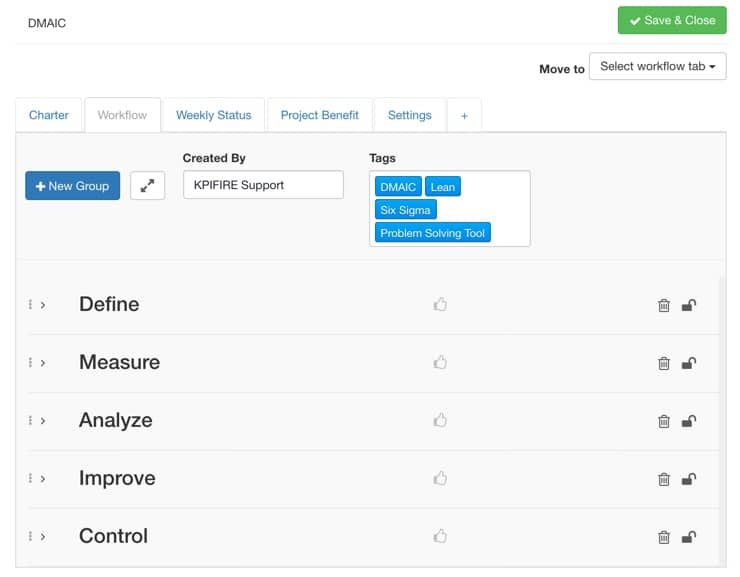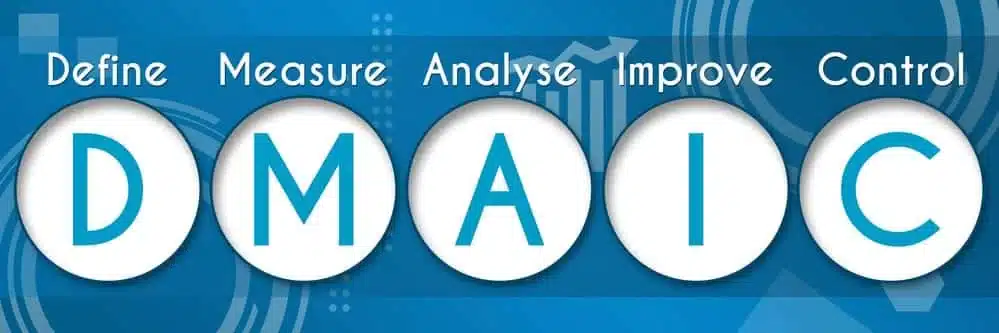In the dynamic world of business, continuous improvement is essential for organizations to stay competitive and achieve excellence. One powerful tool that has proven its effectiveness in driving significant process enhancements is the DMAIC methodology. This acronym stands for Define, Measure, Analyze, Improve, and Control, and it represents a structured, data-driven approach to problem-solving and process optimization. Join us as we unveil all you need to know about the DMAIC process and how to implement it in your organization.
Main Takeaways from This Article
- DMAIC is a structured, data-driven methodology for process improvement: It involves five phases: Define, Measure, Analyze, Improve, and Control, guiding organizations through a systematic approach to identify and solve process problems.
- DMAIC focuses on continuous improvement: By addressing root causes and implementing sustainable solutions, it helps organizations achieve long-term performance enhancements in areas like efficiency, quality, and customer satisfaction.
- Key Differences between DMAIC and DMADV: DMAIC is used to improve existing processes, while DMADV is used to design new processes or products.
- DMAIC is most effective when: Addressing complex problems, where data is readily available, and the potential impact of improvement is significant.
- KPI Fire can support DMAIC implementation: By providing a platform for data collection, analysis, and visualization, KPI Fire can streamline the DMAIC process and enhance the effectiveness of improvement initiatives.
What Is DMAIC?
DMAIC stands for Define, Measure, Analyze, Improve, and Control (pronounced “Dee-May-ik”). These five phases form a structured problem-solving approach widely used in Lean Six Sigma to enhance existing processes and performance.
- Define: Clearly identify the problem and set the project’s objectives.
- Measure: Gather data to understand current performance.
- Analyze: Investigate data to identify the root cause of the problem.
- Improve: Develop and implement solutions to resolve the issue.
- Control: Sustain improvements and ensure long-term results.
DMAIC vs. DMADV
DMADV stands for Define, Measure, Analyze, Design, and Verify. It’s a methodology used for designing new products, processes, or services.
Key Differences:
- DMAIC: Improves existing processes.
- DMADV: Designs new processes or products.
When to Use:
- DMAIC: When you have an existing process with identified problems.
- DMADV: When you’re creating something new or significantly redesigning an existing process.
Why the DMAIC Process Works
The DMAIC process has become a cornerstone of process improvement methodologies due to its rigorous and data-driven approach. It provides a structured framework that ensures a systematic and comprehensive evaluation of any process, leading to tangible and sustainable results.
Structured Framework
A standardized DMAIC approach ensures consistency and clarity across projects, facilitating collaboration, knowledge sharing, and continuous improvement. It provides a common language and framework for problem-solving, making it easier to train new team members and maintain process documentation.
Data Driven Decisions
DMAIC’s emphasis on data collection and analysis ensures objectivity and accurate results by minimizing bias and relying on factual evidence. The use of well-defined metrics allows teams to track progress, identify root causes, and evaluate the effectiveness of improvement solutions, leading to data-driven decisions that are more likely to achieve desired outcomes.
Root Cause Focus
The Analyze phase of DMAIC focuses on identifying the true root causes of issues through various data analysis techniques, such as root cause analysis tools (e.g., fishbone diagrams, 5 Whys). By addressing the root causes rather than just the symptoms, teams can prevent recurring problems and implement sustainable solutions that deliver long-term improvements in process performance.
Sustainable Improvement
The Control phase of DMAIC ensures long-term success by establishing mechanisms to monitor and maintain improvements. This includes implementing control plans, conducting regular checks, and making necessary adjustments to ensure that the gains achieved during the improvement phase are sustained over time. Continuous monitoring and adjustments are crucial for maintaining the effectiveness of the implemented solutions and preventing the process from reverting to its previous state.
Cross-Functional Engagement
Involving different teams with diverse expertise and perspectives fosters collaboration and enhances problem-solving by providing a more holistic understanding of the issue. Cross-functional engagement increases accountability by ensuring that all stakeholders are involved in the improvement process and committed to the success of the solution.
When Should DMAIC Be Used?
Although DMAIC is a powerful problem-solving method, there are situations where it is not the best approach, such as:
- When the solution is already known: Opt for a “Just Do It” approach instead.
- When rapid change is needed: Use a Kaizen Event for quicker, more immediate results.
How to Identify the Best Project for DMAIC
Selecting the right project is crucial for the successful implementation of DMAIC. Choosing a project that offers significant potential for improvement, aligns with business objectives, and is feasible for the team to tackle will maximize the return on investment and ensure project success.
Problem Complexity
Choosing projects with sufficient complexity is crucial for the effective application of DMAIC. Simple problems can often be resolved through quick fixes or minor adjustments. DMAIC’s rigorous methodology, including data collection, analysis, and root cause identification, is most valuable when addressing complex issues that require a thorough investigation and a structured approach to develop sustainable solutions.
Potential Impact
To assess the potential impact of a project, consider the potential cost savings, efficiency gains (e.g., reduced cycle times, increased throughput), and improvements in customer satisfaction. Quantify these potential benefits whenever possible. Additionally, ensure the project aligns with strategic business goals to maximize its value and ensure it contributes to the overall success of the organization.
Data Availability
The success of a DMAIC project hinges on the availability of reliable data. Sufficient data is essential for accurate measurement, analysis, and informed decision-making throughout the process. If data is not readily available, the feasibility of collecting the necessary data should be carefully assessed. The quality and reliability of the data directly impact the accuracy and validity of the project’s findings and conclusions.
Feasibility and Scope
Before embarking on a DMAIC project, it’s essential to evaluate its feasibility within the company’s available resources (time, budget, personnel) and timeline constraints. Defining a clear, achievable scope is crucial to avoid resource overextension and ensure the project remains focused and manageable. This involves setting realistic goals, identifying key deliverables, and establishing clear boundaries for the project.
Continuously Improve With Our Latest News & Updates
The Five DMAIC Process Phases
Control, is a structured, data-driven methodology used for continuous process improvement. This five-phase approach provides a systematic framework for identifying, analyzing, and resolving process issues, leading to significant enhancements in efficiency, quality, and customer satisfaction. Let’s delve deeper into each of these critical phase.
1. Define Phase
The Define phase is the foundational stage of the DMAIC process. Its primary objective is to clearly define the project scope and establish a solid foundation for successful execution. The Define phase of DMAIC establishes the foundation for successful improvement. It begins by clearly defining the problem or opportunity and selecting a qualified project leader and team. A crucial step involves setting a SMART goal, a specific, measurable, achievable, relevant, and time-bound objective linked to a key performance indicator.
Furthermore, understanding the Voice of the Customer (VOC) through stakeholder analysis is paramount. This involves identifying and understanding customer needs and expectations. Finally, the project scope is defined using tools like SIPOC diagrams, and the project charter and team are reviewed with the sponsor to ensure alignment and secure necessary support. These steps ensure a shared understanding of project objectives and pave the way for successful implementation of subsequent DMAIC phases.
2. Measure Phase
The Measure phase of DMAIC focuses on collecting and analyzing data to establish a baseline for process performance. A critical first step involves creating a comprehensive measurement plan, defining data sources, collection methods, and the frequency of data collection.
To ensure data accuracy and reliability, the measurement system is validated using techniques like Gauge R&R. Furthermore, “walking the process” provides valuable insights by observing the process firsthand, identifying potential data collection points, and gaining a deeper understanding of the workflow. By visually representing the current process flow through process maps or value stream maps, the team can identify areas for improvement and potential bottlenecks. This thorough data collection and analysis provide valuable insights into current process performance, enabling the team to establish a baseline for tracking progress throughout the project.
3. Analyze Phase
The Analyze phase delves into the root causes of the issues identified in the Measure phase. A key aspect involves identifying sources of variation and waste within the process. Tools like fishbone diagrams and the 5 Whys are employed to conduct thorough root cause analysis, uncovering the underlying factors contributing to the problems.
Furthermore, the team formulates hypotheses about the relationships between inputs and outputs, represented as Y=f(x1, x2, …xn). This helps understand how changes in inputs impact the process. By clearly defining the gap between current and desired performance, the team sets the stage for developing targeted and effective improvement solutions that address the core issues and deliver sustainable results.
4. Improve Phase
The Improve phase focuses on developing, implementing, and validating improvement solutions. The team begins by brainstorming potential solutions, considering the root causes identified in the Analyze phase. This is followed by the creation of a detailed improvement plan, outlining the proposed changes, the implementation timeline, and the resources required.
The team then implements the process improvements, incorporating techniques such as mistake-proofing to minimize the occurrence of errors. Finally, the team rigorously validates the changes, collecting data to assess the effectiveness of the implemented solutions and ensuring they deliver the desired results.
5. Control Phase
The Control phase is crucial for ensuring the sustainability of improvements achieved throughout the DMAIC process. This phase focuses on maintaining the gains and preventing the process from reverting to its previous state.
Key activities include establishing a robust control plan, which may involve implementing control charts to monitor key metrics and ensure process stability. Updating process documentation and training operators and leadership on the new process are essential for ensuring consistent execution. Leadership standard work is established to provide ongoing support and guidance to operators
DMAIC Examples
1. Healthcare
Reducing Hospital Readmissions
A hospital implemented DMAIC to analyze patient readmission rates for a specific condition (e.g., heart failure). They defined the problem, measured key metrics, analyzed root causes (e.g., inadequate discharge planning, lack of patient education), improved discharge procedures and patient education programs, and established a control plan to monitor readmission rates and make adjustments as needed.
2. Manufacturing
Improving Product Quality
A manufacturing company used DMAIC to reduce defects in a particular product line. They defined the defect types, measured the defect rates, analyzed the root causes (e.g., machine malfunction, incorrect material, operator error), implemented corrective actions (e.g., machine maintenance, operator training, process adjustments), and established a control plan to monitor defect rates and maintain the improved quality levels.
3. Customer Service
Reducing Call Center Wait Times
A call center implemented DMAIC to reduce customer wait times. They defined acceptable wait times, measured average wait times and call abandonment rates, analyzed the root causes (e.g., insufficient staffing, inefficient call routing, complex call handling procedures), improved call routing processes, optimized staffing levels, and implemented a control plan to monitor wait times and ensure customer satisfaction.
4. Finance
Streamlining Loan Processing
A financial institution used DMAIC to streamline its loan processing procedures. They defined key performance indicators (KPIs) such as loan processing time and approval rates, measured current performance, analyzed bottlenecks and inefficiencies in the process, implemented process improvements (e.g., automation, online applications), and established a control plan to monitor processing times and ensure customer satisfaction.
5. Supply Chain
Reducing Inventory Levels
A retail company implemented DMAIC to reduce inventory levels while maintaining adequate stock availability. They defined target inventory levels, measured current inventory levels and stockouts, analyzed the root causes of excess inventory (e.g., inaccurate demand forecasting, inefficient ordering processes), improved demand forecasting and inventory management processes, and established a control plan to monitor inventory levels and ensure optimal stock availability.
These examples demonstrate the versatility of DMAIC across various industries. By systematically applying the DMAIC methodology, organizations can achieve significant improvements in efficiency, quality, and customer satisfaction.
Unlock the Power of DMAIC with KPI Fire
The DMAIC process offers significant benefits, including reduced costs, improved quality, increased efficiency, enhanced customer satisfaction, data-driven decision-making, and a framework for continuous improvement. By systematically addressing inefficiencies, eliminating waste, and focusing on data-driven solutions, DMAIC empowers organizations to achieve operational excellence and gain a competitive advantage in the marketplace.

KPI Fire’s tools and solutions can significantly enhance the implementation and execution of DMAIC by providing a centralized platform for data collection, analysis, and visualization.
To experience firsthand how KPI Fire can revolutionize your process improvement initiatives, we encourage you to request a demo today. Our expert team will guide you through the platform, demonstrating how KPI Fire can empower your organization with data-driven insights and streamline your DMAIC journey.





